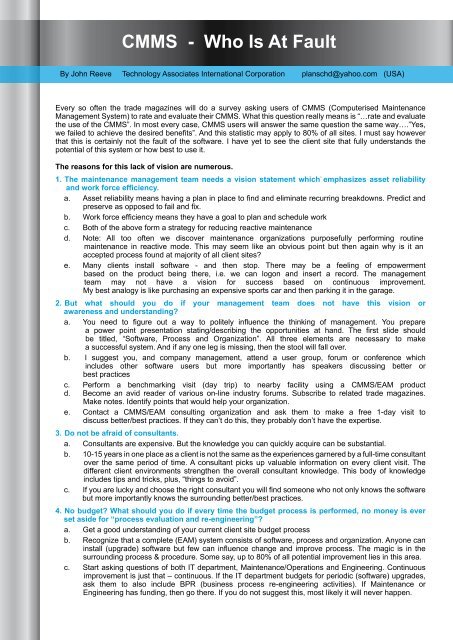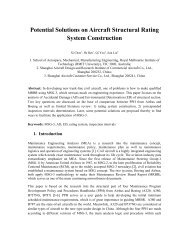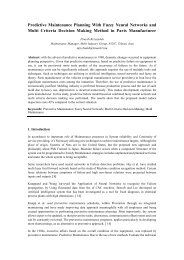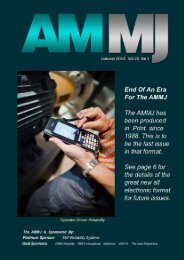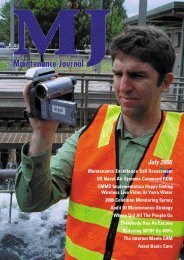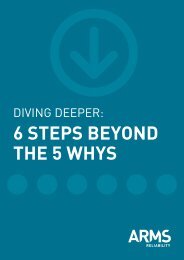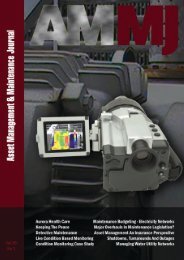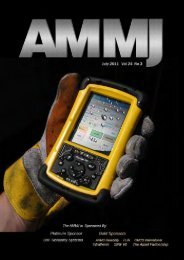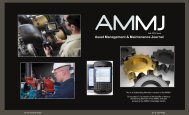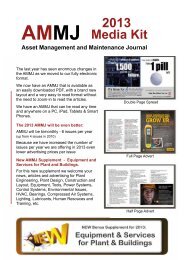DAY 1 - AMMJ
DAY 1 - AMMJ
DAY 1 - AMMJ
You also want an ePaper? Increase the reach of your titles
YUMPU automatically turns print PDFs into web optimized ePapers that Google loves.
CMMS - Who Is At FaultBy John Reeve Technology Associates International Corporation planschd@yahoo.com (USA)Every so often the trade magazines will do a survey asking users of CMMS (Computerised MaintenanceManagement System) to rate and evaluate their CMMS. What this question really means is “…rate and evaluatethe use of the CMMS”. In most every case, CMMS users will answer the same question the same way….”Yes,we failed to achieve the desired benefits”. And this statistic may apply to 80% of all sites. I must say howeverthat this is certainly not the fault of the software. I have yet to see the client site that fully understands thepotential of this system or how best to use it.The reasons for this lack of vision are numerous.1. The maintenance management team needs a vision statement which emphasizes asset reliabilityand work force efficiency.a. Asset reliability means having a plan in place to find and eliminate recurring breakdowns. Predict andpreserve as opposed to fail and fix.b. Work force efficiency means they have a goal to plan and schedule workc. Both of the above form a strategy for reducing reactive maintenanced. Note: All too often we discover maintenance organizations purposefully performing routinemaintenance in reactive mode. This may seem like an obvious point but then again why is it anaccepted process found at majority of all client sites?e. Many clients install software - and then stop. There may be a feeling of empowermentbased on the product being there, i.e. we can logon and insert a record. The managementteam may not have a vision for success based on continuous improvement.My best analogy is like purchasing an expensive sports car and then parking it in the garage.2. But what should you do if your management team does not have this vision orawareness and understanding?a. You need to figure out a way to politely influence the thinking of management. You preparea power point presentation stating/describing the opportunities at hand. The first slide shouldbe titled, “Software, Process and Organization”. All three elements are necessary to makea successful system. And if any one leg is missing, then the stool will fall over.b. I suggest you, and company management, attend a user group, forum or conference whichincludes other software users but more importantly has speakers discussing better orbest practicesc. Perform a benchmarking visit (day trip) to nearby facility using a CMMS/EAM productd. Become an avid reader of various on-line industry forums. Subscribe to related trade magazines.Make notes. Identify points that would help your organization.e. Contact a CMMS/EAM consulting organization and ask them to make a free 1-day visit todiscuss better/best practices. If they can’t do this, they probably don’t have the expertise.3. Do not be afraid of consultants.a. Consultants are expensive. But the knowledge you can quickly acquire can be substantial.b. 10-15 years in one place as a client is not the same as the experiences garnered by a full-time consultantover the same period of time. A consultant picks up valuable information on every client visit. Thedifferent client environments strengthen the overall consultant knowledge. This body of knowledgeincludes tips and tricks, plus, “things to avoid”.c. If you are lucky and choose the right consultant you will find someone who not only knows the softwarebut more importantly knows the surrounding better/best practices.4. No budget? What should you do if every time the budget process is performed, no money is everset aside for “process evaluation and re-engineering”?a. Get a good understanding of your current client site budget processb. Recognize that a complete (EAM) system consists of software, process and organization. Anyone caninstall (upgrade) software but few can influence change and improve process. The magic is in thesurrounding process & procedure. Some say, up to 80% of all potential improvement lies in this area.c. Start asking questions of both IT department, Maintenance/Operations and Engineering. Continuousimprovement is just that – continuous. If the IT department budgets for periodic (software) upgrades,ask them to also include BPR (business process re-engineering activities). If Maintenance orEngineering has funding, then go there. If you do not suggest this, most likely it will never happen.


